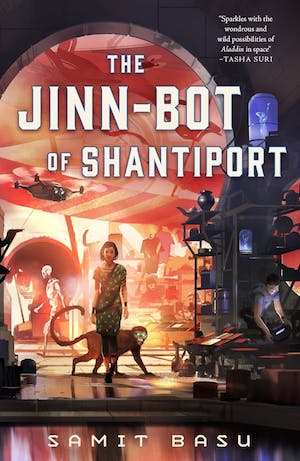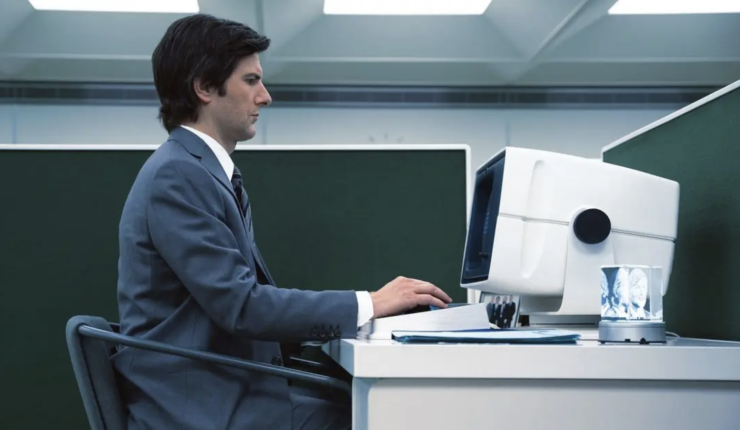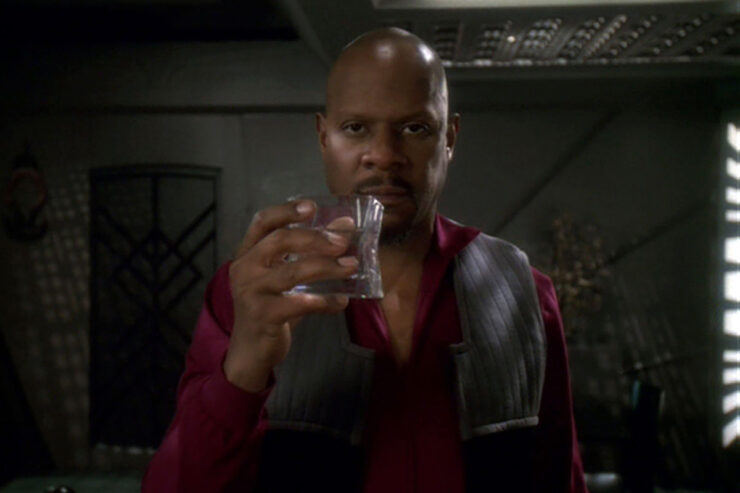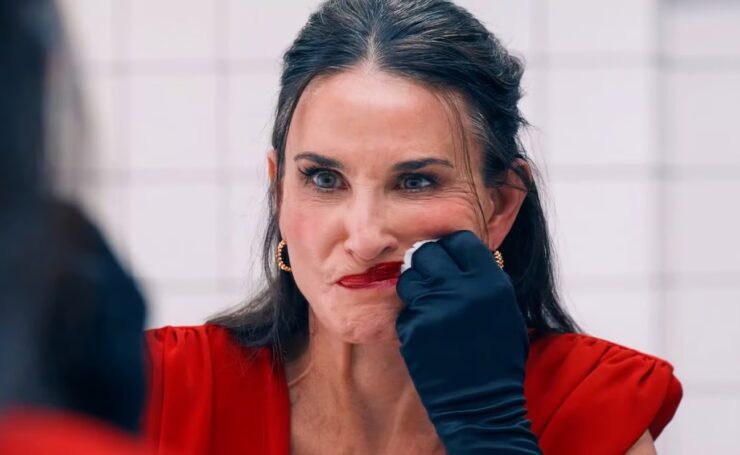The thought occurred to me from the very first scene, even if I wasn’t fully cognizant of it. A woman lies unconscious, sprawled across a conference table in a windowless conference room. As she stirs, a speakerphone crackles to life: “Who are you?” The woman—Helly R. (Britt Lower)—is confused, then panic-stricken, then angry. Very angry. So angry that when her interrogator, Mark S, aka Mark Scout (Adam Scott), finally shows his face, she promptly clocks him on the head with the speakerphone and tries to escape.
[NOTE: I think I’ve successfully avoided all the big reveals of Severance’s first season, but of necessity some smaller spoilers had to be included.]
We soon enough learn that Helly is the newest—if not the most enthusiastic—employee of biotech concern Lumon Industries, and the latest to be inducted into their Severance program. A chip has been implanted in her brain, bifurcating her conscious self. When she takes an elevator down to the subterranean Severed floor, the Helly of the outside world goes away, and the Severed Helly, knowing only the stark, sterile environs of her workplace, takes over. She’s the same person, but neither side has any idea of who the other is, or what that other does across the divide.
The TV series Severance (2022) starts with a simple premise: Lumon has discovered a technological solution to the mythical work-life balance—once Severed, what you do on the job no longer intercedes on your personal life, and vice versa. As comedian Drew Carey would say, “It’s almost a good idea.”
But series creator Dan Erickson—along with directors Ben Stiller and Aoife McArdle—have managed to drill down to explore how ominous this concept would be, once put into action. While the “Outies”—the people the Severed are when they’re not on the Severed floor at Lumon—think that their work has something to do with handling archival materials, we discover the actual activities in the underground office are quite a bit stranger.
Helly, Mark, and their coworkers Irv (John Turturro) and Dylan (Zach Cherry) work in the Macrodata Refinement division, which means they spend their hours staring at CRT screens, using a trackball to corral sets of undulating numbers that provoke a particular emotional response—“scary” seems to be the most prevalent—and drop them into hinged hoppers at the bottom of the screen. Later in the series, the team will have encounters with the Optics and Design department, headed up by Burt (Christopher Walken) and tasked with creating various printed materials, as well as a series of faux oil paintings illustrating the exploits of Lumon founder Kier Eagan. And Helly and Mark will eventually stumble upon a wing in which a lone worker is nursing a clutch of baby goats. Whatever’s going on in Lumon’s basement, it isn’t the development of the next Quibi.
In fact, what is going on seems to have very little to do with any tangible business pursuit, and more with the inculcation of a quasi-religious cult of personality, built around Kier Eagan and his progeny. Among the “Innies,” the founder is exalted as a noble prophet imbued with near-godlike powers. His counsels are invoked as holy writ; a “Perpetuity Wing” enshrines effigies of the Eagans as a whole and Kier in particular, complete with a full-size replica of the founder’s house.
That’s indoors.
And underground.
It is possible the Severed floor is practically boundless.
But the devotion of the people who labor on the Severed level isn’t always so absolute. It runs from the near-fanatical adherence of Harmony Cobel (Patricia Arquette), the unSevered supervisor of the department, to Irv’s more benign reverence, to Helly’s resolute antagonism, with Dylan going along for the ride so long as he gets his perks, and Mark positioned as the affable middle manager who’s beginning to question his complacency (an Adam Scott specialty, which he does to perfection here).
Buy the Book


The Jinn Bot of Shantiport
It’s that tension between the all-business milieu and a culture that seeks to insinuate itself into the very beings of its participants that triggered something in me; and it all got kicked off in that very first scene. And what was the thing that pulled that trigger in my brain? Believe it or not, it was the speakerphone. Remember the speakerphone? It isn’t one of those Polycom-type, spider-like devices that you’d find in any modern business place. It’s a small box, with an off-white case and a black grid at the front. And if you were born before 1980, you recognize that device immediately. It’s clearly inspired by the speakerphone, the one introduced by Bell Telephone in the late Fifties and went on to have a thriving life in conference rooms over the next few decades.
The speakerphone’s presence in a show set in the present day made more sense once I became curious about the building the Severance producers used as the Lumon campus. It’s a low-slung, elemental, mirrored-glass box set into a large oval of ground, flanked front and back by parking lots and on the sides by lakes ringed by park-like promenades. It evokes the industrial within the organic, and looks especially bleak in the snow-covered environs frequently captured by Severance’s cameras. And it turns out it’s real. It’s in New Jersey. And it was once home to… wait for it… Bell Labs. And the really interesting thing about that building, the thing that allowed the cognitive tumblers to finally fall into place for me, is that it was designed by Eero Saarinen.
Okay, we’re going down a rather convoluted path here, so strap in. Eero Saarinen was one of the premiere modern architects of the twentieth century. He had a unique skill for using clean, graceful forms to create a sense of epic scale. Among his creations were St. Louis’ Gateway Arch, and the magnificent TWA Terminal at New York’s JFK Airport. And while the actual Bell Labs building presents a boxy silhouette, its setting, among gracefully arced parking rows, greens-rimmed pools, all positioned within a large oval, is pure Saarinen.
And most importantly for our conversation was that two of Saarinen’s proteges were Charles and Ray Eames. A couple best known for their furniture design—particularly the iconic Eames Chair, an authentic model of which is still available for the low, low price of $4300—they also were responsible for the IBM Pavilion at the 1964/1965 New York World’s Fair.
(For the benefit of those born after 1980, a “World’s Fair” was a grand gathering of nations showing off the magnificence of their (sometimes dictator-led) cultures, while mammoth corporations—which weren’t as mammoth as they are now, but still pretty damn big—showcased all the wonderful technological advances they were working on. The idea on the corporate side was for the likes of DuPont (whose Teflon would one day become more a part of the human condition than anyone could have imagined), General Electric (nuclear weapons), and, yes, Bell Telephone (iron-fisted monopoly on the lines of communication) to show how, under their watch, humanity was on a glide-path toward a future of peace, prosperity, and endless consumption.)
The IBM pavilion itself was one of the fair’s most impressive structures. From a distance, it presented as a giant white egg perched on top of a metal “nest,” which itself was suspended over an open-air court. Prominent within that court was a bleachers-like audience section—the People Wall—which would be lifted by hydraulics up into the egg, where a multi-screen presentation demonstrated how computers mirrored the processes of the human brain.
All these exhibits were stirring visions of a world to come. They had a definite impression on a young Daniel Persons, although in my case it was for how they kickstarted my obsession with entertainment technologies—the immersive domed theaters; the automated presentation systems; all those screens! Turns out I was in good company: They also made their mark on one Walter Elias Disney, whose animatronic figures populated several pavilions, including GE’s Carousel of Progress (theme song: There’s a Great Big Beautiful Tomorrow), and who would go on to take that inspiration and dream of an amazing, futuristic city: the Experimental Prototype Community of Tomorrow.
In Disney’s vision, E.P.C.O.T would be the place where people would live, work, and play within an pre-planned utopia (one whose layout, viewed overhead, bears an eerie resemblance to Saarinen’s Bell Labs footprint). Thanks to the support of corporate benefactors, there’d be no poverty, corruption, or decay, just a paradise of continuously evolving, cutting-edge technology, productive employment, and family-friendly leisure entertainment. (In the actual, aborted plans for the project, there also would be no voting, ‘cuz who would want to alter such visionary leadership?)
It was in Disney’s—and the other flawed prognosticators’—1960s fantasy of an all-encompassing corporate future that I sensed the ultimate crossover with Severance. The maze-like corridors and wide, open cubicle chambers of Lumon’s Severed floor are not any old anonymous white environs, they are the anonymous white environs of a particular time. Of the form-follows-function office towers of the Fifties and Sixties, of a design sense that was meant to bespeak efficiency, but with style. It’s there in the typography of the department signs, it’s there in the throwback tech—the CRT screens and the giant trackballs constantly moving and clicking—and it’s there in that goddamn boxy speakerphone.
On the show, characters frequently reference the Severance floor and its no-escape structure as Hell, but the most Sartrean thing about it may be the sense that the entire facility seems to have entered the Sixties and never left. The effects of an office culture trapped in amber (or whatever substance would best evoke those white walls… alabaster?) are everywhere to be seen—there are empty departments that seem to have been mothballed for years; there’s at least one conference room that likely hasn’t taken a meeting for just as long. There’s the suggestion that the Severed floor was a more bustling hive of activity long ago, and that over the decades its business has dwindled down to a clutch of employees whose work is at best enigmatic, if not outright pointless.
And trapped in there as well seems to be an antiquated notion of what a corporation is, and how it should factor into our lives. On the Severed floor, there’s no differentiation between Lumon Industries and the cult of Eagan. As was rhapsodized at the World’s Fairs of the latter half of the last century, the corporation of the Severeds remains an entity striving to be the custodian of our shining, happy future. When it’s victorious, we celebrate; when it’s challenged, it becomes our struggle as well. If the corporation could be seen as an organism, the Severeds are its component parts, its heart and lungs and (ew) bowels, existing to support the body and, pointedly, readily replaceable if they fail at their tasks. (One chamber of the Perpetuity Wing features rows upon rows of photographs of disembodied smiles, people supposedly helped by Lumon, but also—not dissimilar to the stacked fairgoers who formed IBM’s People Wall—anonymous bricks in the company’s legend.)
Thing is, the world has moved on from this philosophy—or more to the point, corporations have become so grotesquely monolithic that it’s increasingly difficult to accord any kind of humanistic motivation to them—but Lumon has not, and is apparently determined to expand its antiquated worldview, and the technology that facilitates it, beyond just the Severed floor. In the last episode of Season 1, Helly wanders around a Lumon exhibition in which giant photographs are mounted on rotating, back-lit cubes—a presentation that would not have felt out-of-place in ’64/’65. And in an earlier episode, Mark’s sister Devon (Jen Tullock), while delivering her baby at a natural birthing retreat, encounters a woman who apparently has been Severed to spare her the trauma of labor pains. That woman is the wife of a politician that Lumon is courting to help legislate the Severance technique into widespread use.
I’m not completely immune to the perspective through which the likes of Walt Disney viewed the future. The ol’ Mousetro, for all his faults, firmly believed that there was no problem technology could not solve, that industry unleashed would build a paradise where all would thrive. It would get rid of the messiness of politics, and want, and disease. We’d work for our benevolent corporations, and they in turn would assure that we need for nothing.
It’s a comforting idea, one that ignores that corporations more often than not function for their own survival, free of human morality. That the tech that might promise monorails, microwave ovens, and dishwashing robots also has no objection to bringing into existence napalm, OxyContin, and Xwitter. There’s an ideal that’s been trapped on the Severed floor, an ideal who’s time has come and passed, and which in the intervening decades has curdled into something monstrous. Best the monster be caged, trapped in those soulless corridors, until it withers and dies for good.
* * *
Let me be blunt: Severance is one of the most spectacular, visionary, and incisive TV series ever. It features some of Ben Stiller’s best directing work (along with Aoife McArdle), and incredible performances from the entire ensemble, but especially from Scott and Lower as (respectively) an everyman rousing from a state of denial and a woman steadfastly fighting against the system, plus Turturro as a worker finding his faith in the system severely tested, and Arquette as a fanatic increasingly frustrated that her devotion hasn’t been sufficiently rewarded.
I’ve only managed to scratch one small corner of the series’ worldview—I haven’t even touched on the whole drama of Mark’s life off the floor, and how events there, most critically his encounter with a formerly Severed colleague, affect his workplace self. If you can bring further insight into the show or have a different interpretation, we’d all love to hear it. Please use the comments section below, and remember to keep it friendly and polite. What gets read here will be remembered.
Dan Persons has been knocking about the genre media beat for, oh, a good handful of years, now. He’s presently house critic for the radio show Hour of the Wolf on WBAI 99.5FM in New York, and previously was editor of Cinefantastique and Animefantastique, as well as producer of news updates for The Monster Channel. He is also founder of Anime Philadelphia, a program to encourage theatrical screenings of Japanese animation. And you should taste his One Alarm Chili! Wow!















For some reason I’d managed to make it this far never having heard of Severance – definitely sounds worth watching.
The idea of on-duty/off-duty brain bifurcation pops up, in an even more chilling form, in (where else) Peter Watts’ Echopraxia, where soldiers are given the chance of suppressing their entire conscious selves for the duration of a term of service – becoming philosophical zombies, with the side-effect that their brains will be much faster and more efficient without the cognitive parasitic drag of consciousness. (Watts doesn’t think consciousness is particularly adaptive.)
mammoth corporations—which weren’t as mammoth as they are now, but still pretty damn big
This sent me off down a bit of a rabbit hole – I wonder what the biggest corporations in history were, relative to the size of the economy at the time? As in, Apple is huge now, but is it bigger compared to world GDP than, say, Standard Oil or US Steel or the Honourable East India Company? The world economy was a lot smaller in 1900, let alone 1800.
Really interesting piece, I hadn’t really considered this connection. The fact that their is a (no spoiler) certain on-site attraction that supports a cult of personality worship fits right in.
For me one of the best things about the show is how well the archetypes of each character are presented. Tramell Tillman’s Milchick also deserves a huge shout, it was a wonderful portrayal of someone many people watching have already worked under.
@2 Lifeknell: Agree on Tillman — great work.
Corporations of this type, most especially Disney, were also famed for their hostility to unions. The Depression-era cartoonists’ strike in the House of the Mouse is some pretty nasty stuff. (Walt, like Henry Ford, was a reactionary Midwesterner who felt that he owned the workers because he created their jobs, and they were vile ingrates to want a piece of the prosperity they built. Contrary to persistent legends, though, Walt doesn’t seem to have been antisemitic.)
A few weeks ago I had a medical exam which, in Unistat but not the rest of the world, is customarily performed under what they call ‘conscious sedation’ and really means using midazolam or propofol to keep you from remembering what you are experiencing.
I wasn’t consciously thinking of Severance when I absolutely refused this ‘service’ but it may have been in the back of my mind.
A great series no doubt.
I was struck by the grotesque irony of Helly R’s survival at Lumon and the Foxconn workers that commited suicide while making Apple products in real life.
Oooh, this is quite a fascinating comparison, and I can absolutely see how it follows along.
Here’s the eerie thing: when I saw the Severed wing hallways, they were utterly familiar to me. My dad used to work for the corporate side of Chevron, and all through my childhood in the 80s and 90s I have strong memories of visiting him in his office at Chevron Park in San Ramon, California. The corridors and hallways inside the building were almost exactly the same–white metal walls with taller ceilings than you’d expect, identical doors, larger rooms with cubicles, all very labyrinthine and hard to navigate unless you worked there.
That park was built in the early 80s, but definitely had the lingering feeling of something from the 60s or 70s.
One recalls the general feel of the arcology in Niven/Pournelle’s OATH OF FEALTY, too. Though in that book it tries to be more Mall of America than Epcot Center, the place smells like a giant trap culturally if not physically.
@8 excessivelyperky: There are hints of rat maze to the setup, and the work of Macrodata Refinement contains whiffs of behavioral experiments involving pigeons and primates, including the occasional rewards. Whether that will pay off, I don’t know.